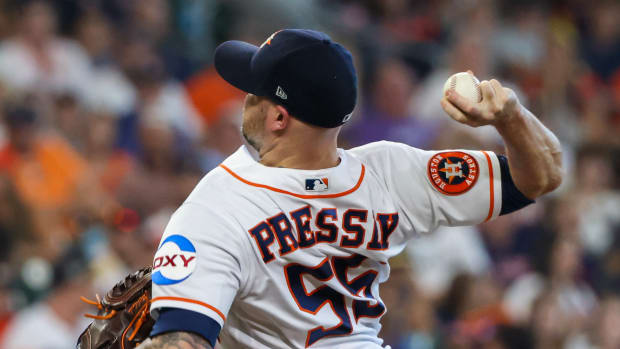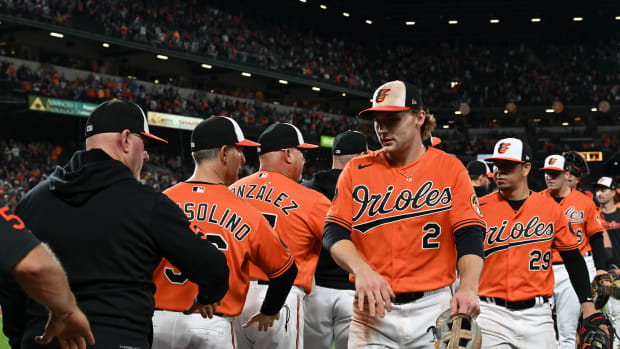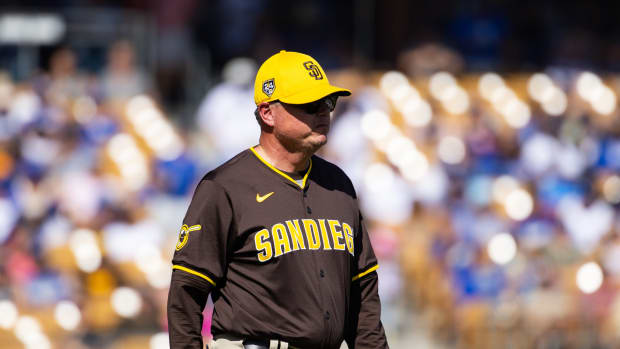The Verlander Game: Astros' New Ace Delivers Dominance While Embracing Team's Analytical Approach
HOUSTON—In the Houston Astros clubhouse Justin Verlander pulled on a suit—a suit, it must be pointed out given the way he had just pitched Saturday, that did not include a cape—and just kept wrenching postseason baseball further back in time, back to long October shadows, Gibsonian glares, Kodachrome snapshots and bullpen doors that never opened.
“Ice?” he replied to a question about arm care after he became only the seventh man to throw a postseason complete game with as few as five hits and as many as 13 strikeouts. The great Bob Gibson had been the first. “No. I never ice.”
Game 2 of the ALCS, a 2-1 victory for Houston over the Yankees, will go down as The Verlander Game. In one of the rarest exhibitions of pitching and purpose the game allows these days, Verlander threw a complete game with 124 pitches, something that had not been done in 10,776 consecutive regular season and postseason starts, dating to 2015. The last of 71 fastballs he threw, his penultimate pitch, was clocked at 96.7 miles per hour.
All of it—the nerve and verve, the hellacious slider made possible by escaping Detroit for the Astros and their state-of-the-art technology, the purpose and re-commitment he found from an undressing three years ago from his manager—all of it Saturday risked the emptiness of a no-decision if not for something that happened in the Astros’ indoor batting cage before the game.
Designated hitter Carlos Beltran, the team’s wise elder, cranked the pitching machine up to its maximum velocity, then took his place not 60 feet six inches from its missiles but more like 45 to 50 feet. All he could do to get the barrel of his bat on the speeding ball was to keep his lower half quiet and swing compactly and abruptly.
“You’re not training your swing,” he explained before the session. “You’re training your eyes. You want your eyes to get used to tracking velocity, so that when you get out there in the game, with the greater distance, it slows down the ball to your eye.”
Watch: Astros Walk Off With Game 2 Win on Carlos Correa’s RBI Double
Beltran first learned about the drill from Barry Bonds, after Beltran was traded from the Mets to the Giants in 2011. Bonds, out of baseball then, showed Beltran the drill as a way to hit high velocity.
Following Beltran into the cage Saturday was Houston shortstop Carlos Correa. The Astros signed Beltran last December as much for his wisdom as for his bat. Correa has been one of the many young Astros under his counsel. In spring training, Beltran showed Correa the drill. Correa has been using the drill all year.
“It’s made a big difference,” Correa said before Game 2, when he was about to face the game’s hardest throwing starter pitcher, Luis Severino. “I know against his velocity all I have to do is get the barrel to the ball. I don’t need to supply any power myself.”
Bonds to Beltran to Correa—an unbroken line of shared wisdom, the way baseball and its intricacies have been shared generation after generation.
Hitting elite velocity would just so happen to be the key to beating the Yankees, who have pushed people around this year with the hardest throwing staff in recorded history (average heater: 94.5 mph). This is how the Astros beat New York in Game 2 from the offensive side:
* Correa, with his abbreviated swing, punched a 99.3 mph fourth-inning fastball from Severino over the wall in rightfield for a home run. It was the fastest pitch ever hit for a postseason home run since StatCast technology began in 2015.
* Jose Altuve stepped in against Aroldis Chapman, the hardest-throwing dude on the planet, in the ninth inning of a 1-1 game, and promptly smacked the very first pitch, a 100 mph fastball, into centerfield for a single—an impossibility for anyone but this hitting savant who bats .438 against pitches 95 and above.
* Six pitches later, Correa whacked a 99.3 mph fastball from Chapman into the gap in rightcenter, scoring Altuve with the winning run.
“See,” Correa said with a sly grin. “I told you it works.”
(Truth be told, the winning run was made possible by a chain of unkempt play by New York on the relay. Judge took several steps after cutting off the ball and, without truly getting square to his target, made a quick but fairly weak throw toward shortstop Didi Gregorius at second base, rather than getting it to the first cutoff man, second baseman Starlin Castro. The ball bounced on the outfield grass to an alert Gregorius, who spun immediately to throw home. Gregorius was unable to fully step into his throw because Correa, after sliding hard into second, began to pop up and into Gregorius’ midsection.
(Still, Gregorius made a timely throw that arrived on a bounce to catcher Gary Sanchez just as an apparently doomed Altuve had reached the cutout circle of the home plate area. It was a proper and easy send for third-base coach Gary Pettis because Altuve is Houston’s best baserunner and because even with an out the Astros would have had the winning run at second base. Sanchez, choosing to play a difficult in-between hop, peeked toward Altuve just as the ball hit his glove and dropped it. The ball lay stopped into the dirt in from of home as Altuve slid in with the winning run.)
“That,” Correa said, “was the most fun I’ve ever had on a baseball field.”
The average major league fastball these days is 93 miles an hour. No team is better at slugging against above-average velocity (94+) than Houston (.485). Even throwing fireballers Severino, Tommy Kahnle, David Robertson and Chapman, New York was able to strike out only four Astros—only the seventh time in 170 games this year the Yankees struck out so few batters. The Yankees can’t get fastballs past these superb Houston hitters, the toughest bunch of hombres to strike out in all of baseball this year.
The scores in this taut ALCS thus far favor the Astros in games, 2-0, and in runs scored, 4-2, but it is a lopsided affair when it comes to strikeouts by each pitching staff, 27-9. It’s the first time all year Yankees pitchers had no more than five strikeouts in back-to-back games.
Verlander, Gibson-like, piled up 13 strikeouts himself. One day three years ago, in the middle of a down year in which he would post a 4.54 ERA for the Tigers, Verlander was called into the office of manager Brad Ausmus.
“I don’t see you throwing with conviction behind your pitches,” Ausmus said.
A surprised Verlander snapped back at him.
“I guarantee you can pick any pitch that I’ve thrown and I can tell you exactly what I was trying to do with it,” Verlander said.
The two men began to talk, and as they did, Ausmus figured out what truly was missing in his ace’s game: Verlander still was relying only on his instincts and observations to get people out, when an entire world of data was out there to help him. The conversation opened Verlander’s eyes and mind. He began seeking out pitch data, keeping his own hand-written statistics and notes, and visiting a pitching guru of modern data-based mechanics to learn about spin rates, release points and arm health.
When the Tigers traded Verlander to Houston Aug. 31, another world opened for Verlander. The Astros are one of the most forward-thinking, resourceful teams when it comes to analytics, and Verlander not only embraced it all, he also asked for more. The joke among the quants in the organization was that Verlander was the first guy to actually ask for more than the reams of information they already were crunching.
Astros Reward Justin Verlander's Dominance with Walk-Off Win in ALCS Game 2
“Before a game,” Beltran said, “you come in here [in the clubhouse] and he’s at a table with 25 pieces of paper spread out and all kinds of other stuff. He is the most prepared pitcher I’ve ever been around.”
In Houston, Verlander found another tool to improve and modernize his game: a super high-speed camera that shows in clear frame-by-frame detail how a baseball leaves a pitcher’s hand on every pitch. The camera showed Verlander the position of his hand on his slider that needed improvement to give it more tilt. Verlander had always thrown his slider in a way that more resembled a cutter. But with the camera’s help, he began to carve off nasty sliders that bore to the back foot of lefthanded hitters.
Last night the Yankees saw a Verlander nobody had ever seen before. He threw 40 sliders, the most he had ever thrown in the 404 times he pitched a big league game. Thirty-one of those 40 sliders were strikes. Verlander’s precision with elite stuff was mind-boggling. He threw 31 balls to the 32 batters he faced.
“This,” teammate Dallas Keuchel said, “is the most impressive thing I’ve ever seen in the postseason to date.”
Keuchel and Verlander have become not just your clichéd narrative of “a pair of aces,” they also have become fast friends, in great part because of their thirst for the most intricate pitching knowledge. They throw with dissimilar stuff, but have a shared passion for a professorial approach to the art and science of pitching.
Astros–Yankees Gets Weird With Potential Interference, Double Stuck in Fence
“One of the things we’ve talked about is having a plan pitch to pitch,” Keuchel said. “Sometimes it may look like a guy is on you with a swing, but you can’t give up on that pitch. If you don’t have to change, you don’t have to change. And he does that with his fastball. He’s got that high-spin fastball that gets on hitters, and you saw tonight how he kept going to it. If they can’t hit that high fastball, keep throwing it.”
It’s been a series of beautiful, pulsating baseball so far, which harkens back to classics such as the 1980 NLCS, when the Phillies and Astros were never separated by more than three runs in their five games, four of which were tied after nine innings. The Yankees and the world are finding out not just about Keuchel and Verlander and the art of pitching, but also the extreme hitting intelligence of this Houston team. If you needed one at-bat to understand the talent and intellect of these hitters, you could not do better than examining the last.
Correa had never seen Chapman before when he stepped in to bat in the ninth. Chapman, of course, introduced himself to Correa with velocity: first 99.3 and then 99.9. Both pitches missed up and away. Correa decided there at 2-0 to go to “auto-take” mode; he made up his mind he wanted to see another pitch. Chapman threw him a slider—a 2-and-0 breaking ball from the fastest throwing man on earth! Chapman had thrown only five 2-0 sliders all year. It dropped over the heart of the plate for a strike.
“I went, ‘Whoa!’” Correa said, “and realized it was a good thing I was in auto-take.”
Chapman then doubled up on the slider. This one wasn’t nearly as good, as it fell off the plate and down for a ball.
At 3-and-1, Chapman threw a challenge fastball, keeping his fifth straight pitch away to Correa. This time the shortstop swung, and fouled it back.
Yasiel Puig Sparks Dodgers Again in NLCS Game 1 Win Over Cubs
“I just got under it,” Correa said. “So I told myself I would have to make an adjustment. After seeing that pitch, and hitting the bottom of the ball, I knew I would have to get on top of the ball. So I told myself to swing for the top of it, to stay over the baseball.”
It was an incredible piece of data processing in mere seconds with such little information on which to work. Correa had swung at one fastball from Chapman in his life, and now had forged a game plan on how to hit it.
Now the count was full, a count in which Chapman throws 88 percent fastballs. The odds were even greater because he was pitching in a tied playoff game in the ninth inning with a runner at first. He was not going to get beat with his second best pitch when he knew Correa was in swing mode.
That last fastball was 99.3, on the lower edge of the strike zone and the outer edge of the plate. Correa swung as if he were back in the indoor batting cage before the game, executing the drill he learned from Beltan, who learned it from Bonds. At that moment, as the ball sizzled toward the yawning, green space of the outfield, and as the diminutive Altuve began pumping his arms and legs like a boy who feels the joy of what it’s like to run fast and free, you just knew there was no stopping this team.



































